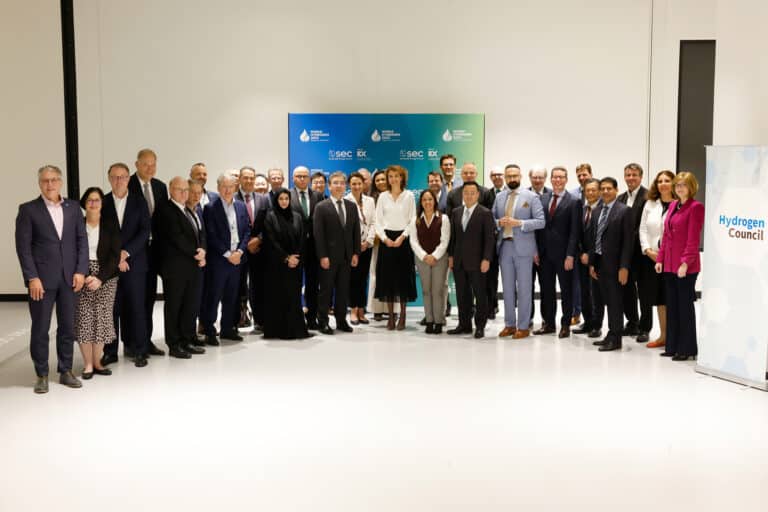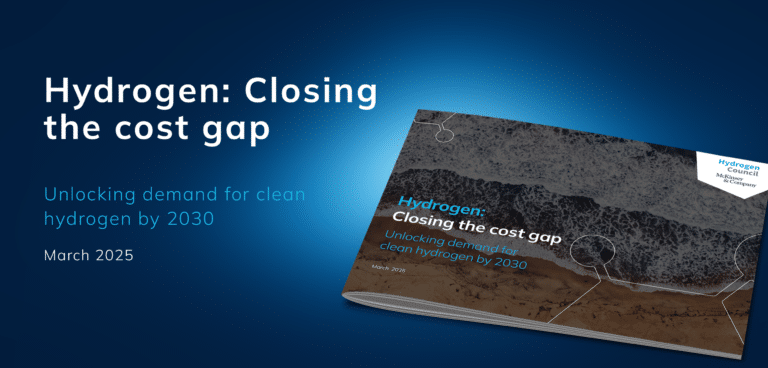This interview by James Burgess was first published in S&P Global Commodity Insights.
Policy headwinds facing low-carbon and renewable hydrogen projects in Europe will be temporary, with projects poised for swift deployment once there is regulatory certainty, the Hydrogen Council told S&P Global Commodity Insights.
The Hydrogen Council’s report, published with McKinsey, “Global hydrogen flows: hydrogen trade as a key enabler for efficient decarbonization”, found that 65 million mt of hydrogen could be transported long distance by 2030, out of a potential annual market of 140 million mt.
The figures were based on demand growth aligned with a net-zero pathway.
In 2030, trade is dominated by pipeline shipments, with some early green ammonia and methanol shipments also starting by that date.
“By 2030, the first piped imports into Europe will occur as domestic hydrogen supply is constrained and available renewable capacity is built up to decarbonize power,” the Hydrogen Council said. “This facilitates competitive low-carbon supplies from markets such as Norway.”
In markets such as Japan and South Korea, “global clean ammonia demand, in addition to clean methanol demand in Asia, will drive shipped exports from Australia, the Middle East, and North America,” it said.
The Hydrogen Council said production costs in Europe, Japan and South Korea in a range of $1.80-$2.50/kg and above would be significantly higher than in low-cost regions, because of land availability constraints and limited capacity to deploy additional onshore wind and solar.
Platts Hydrogen Price Wall shows the world’s cheapest electrolysis-based hydrogen derives from Western Australia, the US, and the Middle East. The cost of producing hydrogen by alkaline electrolysis in Western Australia averaged $3.15/kg in August, compared with $25.35/kg in the Netherlands, based on month-ahead grid power prices, according to S&P Global Commodity Insights data.
By 2050, international trade in hydrogen and its derivatives could reach 400 million mt/year of a total market of 600 million mt/year. Trade could cut hydrogen supply costs by 25% by 2050, saving $6 trillion, the Hydrogen Council said.
US advantage
The analysis for the report was produced before the introduction of the Inflation Reduction Act in the US, which has massively boosted investment in low-carbon hydrogen projects there.
The Hydrogen Council said the IRA would likely make a portion of US production more competitive in the coming decade, though the impact on long-term trade balances was unknown.
Wilson said the US act was prompting Europe and other regions to up their game.
“You have very substantial incentives, which are clear with no ambiguity in the US,” he said. “That is a tremendous investment platform.”
However, the US was starting from a less-developed position on its projects compared with Europe, and Wilson noted too that it was not a “zero-sum game”.
“There is plenty of interest to go around the world to activate projects in Europe, the US, Asia and elsewhere,” he said.
“You have to remember, up until the last year, the US was about five years behind, and so there is a degree of catching up in project proposals and project development.”
European delays
In Europe, on the other hand, there have been years of project genesis and development, along with building consortiums to deliver these.
“The unfortunate thing is we have policy ambiguity and delays in the EU, which is not a good thing for projects to [take final investment decisions],” Wilson said.
Some companies have postponed FIDs on projects in Europe after the European Parliament in September scrapped the proposed “additionality” criteria and relaxed the accounting rules for matching renewable power with electrolysis projects.
The move created uncertainty about the policy landscape, with the timescale for finalizing the revised Renewable Energy Directive not yet clear.
Wilson said the removal of the additionality rule for renewable hydrogen projects in Europe — whereby the electricity to power electrolyzers had to come from additional renewables capacity for the hydrogen to count as renewable — would help projects get off the ground and did not detract from building a renewable power system.
He said the industry needed to do a better job of explaining the role electrolyzers could play in a holistic energy network, balancing grids, operating as an energy store and market maker for new renewables.
“Maximum system efficiency occurs when you let electrolysis play its role basically following market signals,” he said.
Around $750 billion in investment was needed by 2030 to reach clean hydrogen targets in line with net-zero emissions goals by mid-century, and the industry had reached around a third of this level in project announcements, Wilson said.
Utility-scale projects in the 100s of megawatts could be built in around two years, though subsequent projects would benefit from the development of early projects, speeding up deployment and lowering costs, he noted.
Reductions in electrolyzer cost curves were progressing broadly in line with the Council’s expectations from forecasts over the last five years or so, while the outlook for natural gas-based hydrogen production costs should become clearer in the coming six months, as the market potentially stabilizes, Wilson said.



